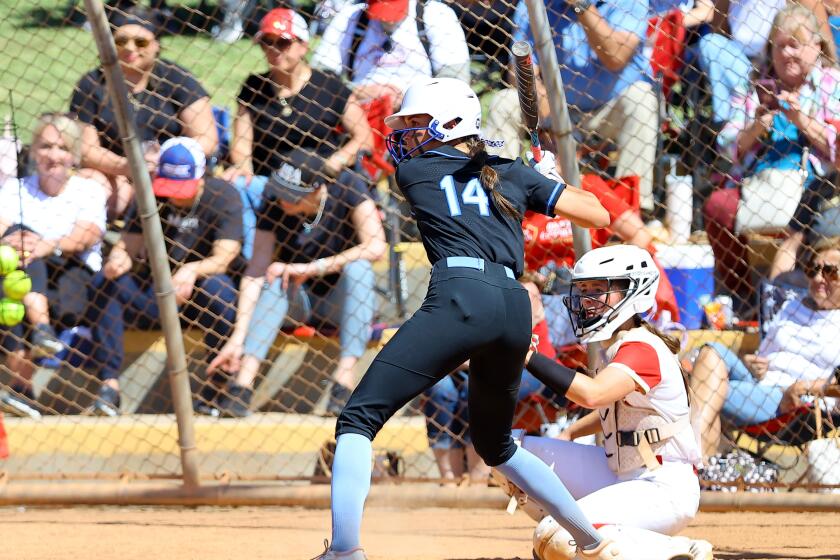The Verdict on Knee Braces Is . . . : Medical Experts and Trainers Have Different Opinions
- Share via
Randy Williams, Edison High School trainer for 12 seasons, has read the medical reports, such as the American College of Sports Medicine study that says lateral guard knee braces do not prevent or reduce injuries.
But for the past four years, Williams says he has seen different results. He cites offensive tackle Randy Goens, whose brace was bent to a point that it was rendered useless.
Goens suffered a second-degree sprain after he was hit flush on the knee in preseason practice. He missed four weeks. Williams says Goens would have been lost for the season without the brace.
“I know the American College of Sports Medicine came to the conclusion that there is no reason why the knee brace should work,” Williams said. “But practical application in four years at Edison tells me they do work. We haven’t had a surgical knee operation here in four years.”
The knee brace, more than any other football safety feature since the helmet, has become controversial. Some medical experts say it does not work as advertised. But some trainers, coaches and players swear by it.
The braces basically protect the knee ligaments from stretching or tearing, Williams said. The brace is taped or strapped on at mid-thigh and mid-calf where the impact is dispersed upon contact. Ideally, the brace acts as a shock absorber.
About 20 manufacturers are producing knee braces, which cost from $60 to $400 a pair, depending on the strength of the brace, additional Velcro straps or cups. A quality brace may be as light as eight ounces yet is able to withstand a force up to 6,000 foot-pounds.
It is estimated that a 250-pound player running the 40-yard dash in 4.8 seconds is the equivalent of 3,500 foot-pounds. The good, lightweight braces are made of aircraft structural alloy.
Who wears the braces? Primarily linemen, but Edison running back Kaleaph Carter also wears them.
Edison was the first Orange County high school to outfit some of its players in braces. Today, Bill Workman, Edison coach, has a mandatory rule that all starting offensive linemen must wear knee braces during practices and games.
In spite of some of the research, Workman said, “I feel they work.”
But do they prevent or reduce injuries?
Orthopedic surgeon Dr. Robert Cassidy, one of the founders of the Sports Medical Clinic of Orange County and team doctor for Marina, Kennedy and Golden West College, said braces are one of the biggest controversies in sports medicine.
“Basically, the jury is still out,” Cassidy said. “There are more players wearing them this year, and we’ve certainly seen no difference in the number of knee injuries we treat at this office.”
George Anderson, Los Angeles Raider trainer for 26 years, invented and patented the Anderson Knee Stabilizer in 1979. He said he has sold 110,000 knee braces since he first built them for quarterback Kenny Stabler.
“I have 18 players on the Raiders wearing them, and it’s not a rare thing to have one of them thank me every Sunday for saving his knee,” Anderson said. “I’ve read the medical reports and you have to remember that those tests were done in a lab.
“I see positive results on the football field every day with guys who make their livelihood off playing football. The doctors like to malign this product, but I don’t see them doing anything to help.”
Chip Marchbank, trainer at Golden West College, cautions that the braces are protective devices, not preventive equipment designed to save the knee.
“If you can save one knee, you pay for the cost of the braces,” Marchbank said. “However, I think that the knee braces are being put on some players under false pretenses.”
The American Academy of Orthopedic Surgeons also questions the motives of some of the manufacturers. Some manufacturers claim their products prevent or reduce the severity of injuries.
The manufacturer of the DonJoy Protective Knee Guard, in its advertising pamphlet, claims to “give players maximum knee protection and comfort.” The pamphlet also says the product will “absorb the lion’s share of the force, distributing the balance along the 16-inch stabilizing hinge bars to the thigh and calf.”
Dale Daniel, MD, associate professor of orthopedic surgery at UC San Diego, told The Physician and Sports Medicine magazine: “We at the American Academy of Orthopedic Surgeons are very concerned that prophylactic braces not be sold as proven items.”
In the article, Lonnie Paulos, MD and clinical professor of orthopedic surgery at the University of Utah, said he concluded that wearing knee braces could actually increase the chance of injury.
“The brace creates different leverage arms across the legs,” Paulos said. “If hit in certain ways, the brace increases the force transferred to the knee.”
More to Read
Get our high school sports newsletter
Prep Rally is devoted to the SoCal high school sports experience, bringing you scores, stories and a behind-the-scenes look at what makes prep sports so popular.
You may occasionally receive promotional content from the Los Angeles Times.






